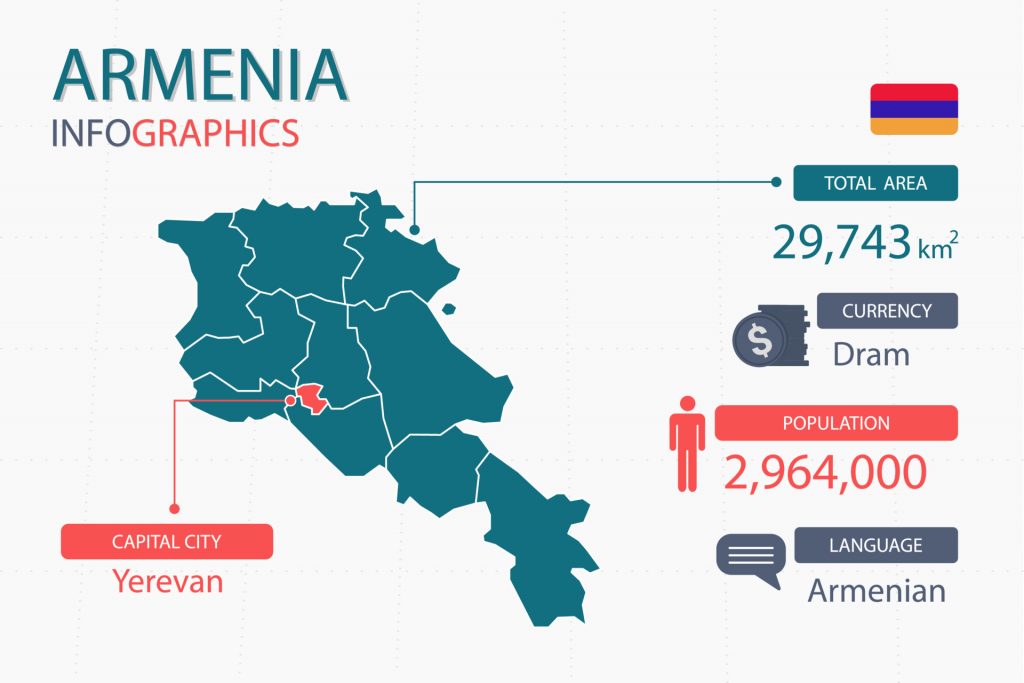The origins of the Armenian Language
Armenian is the official language of both Armenia and the Republic of Artsakh, a small country in the South Caucasus that also has a population that is mostly Armenian. It is a recognized minority language in a number of countries including Cyprus, Iraq, Romanian, and Ukraine. In addition, due to a diaspora that has communities in many parts of the globe, it is also spoken in countries that include Lebanon, Turkey, and the United States, especially in the state of California.
Armenian is known as a language with a long history compared to other languages that have evolved more recently, with a literary history that can be traced back to the 5th century. Interestingly, Armenia as a country has mostly been a monolingual country since the 2nd century BC. With such a long history as a political state, Armenian has also been historically influenced by a number of languages ranging from the more ancient ones to more recent ones, therefore exhibiting an extremely rich vocabulary base. Iranian dialects, Greek, and Persian all played a role in terms of vocabulary in Armenian’s earlier iterations, and of course English in more recent times.
Armenian is a language that is considered to have stemmed directly from the Indo-European language branch. Whereas other languages have had other iterations before they evolved into their current existence, Armenian can be considered separate in this sense. For example, while English has roots in the same branch ultimately, it evolved out of Germanic dialects that came from Indo-European. This direct descent from Indo-European is another reason for Armenian’s long history.
Armenian is written using its own alphabet developed around 405 AD. While it originally had 36 letters, it currently has 39. Like many languages, Armenian is written from left-to-right. Its punctuation system is also rather unique as well. This alphabet has also been used for other languages throughout history, most notably for Turkish, but also for Kurdish.

Armenian grammar exhibits a case system with seven cases. However, it does not classify nouns into grammatical genders. Verbs are also conjugated for tense and mood. Such a system allows Armenian to convey very specific nuances and meanings just by using nouns and verbs alone.
The evolution of the language can be classified into roughly three eras: Classical Armenian, Middle Armenian, and Modern Armenian.
Classical Armenian is dated from the 5th century to the 19th century, even though as a spoken language, only true up until the 11th century. From the 11th century to the 19th century, however, it remained the standard literary language, while Middle Armenian dialects were used vernacularly between the 12th and 18th century. At this time, notable linguistic landmarks include the publication of the first Armenian periodical in 1794. Classical Armenian borrowed many words at this time from Iranian languages, Greek, Arabic, and Persian, which would have an effect on its later linguistic development. Classical Armenian to this day continues to be a liturgical language, most notably for the Armenian Apostolic Church and the Armenian Catholic Church.
The period between the 12th and 18th centuries is where Middle Armenian is placed and refers more to the spoken dialects at this time. As can be seen from the dates, Middle Armenian existed at the same time as Classical Armenian, when the Classical variety was used more for formal purposes. It can also be considered a transition from Classical Armenian to Modern Armenian.
In the 19th century, political and cultural events influenced the development of Armenian as both a literary and vernacular language. First, Armenia was divided with the Eastern part conquered by the Russian Empire and the Western part being under Ottoman control. Furthermore, both of these empires were rivals, and thus, the environments in which Armenian speech communities lived at this time were quite separate between the west and east. Due to this, two major Armenian standard languages were formed, a western standard and an eastern standard.
During this period, despite foreign influences, both standards flourished. Newspapers were published in both standards and education was also conducted with both varieties being employed. As a result, the rate of literacy increased substantially at this time. Moreover, Armenian’s literary tradition continued and adapted to the modern language.
After World War I, Armenia was under control of the Soviet Republic. At this time, Eastern Armenian was used as the official language. Despite the Armenian Genocide in the Ottoman Empire, the diaspora who escaped to various parts of the world has preserved Western Armenian. Eastern Armenian is thus more associated with writers and linguists of the Russian Empire while Western Armenian is closely associated with writers at the time of the Ottoman Empire.
Currently, Armenian is a language with two standardized norms, it’s a pluricentric language without one unifying standard. However, the dialects that are spoken nowadays are mostly mutually intelligible. The language that is spoken in current Armenia is Eastern Armenia while the language of the diaspora is Western Armenia. Both standards remain important as Armenian, as a whole, is a language that unites a certain speech community and culture with a shared history.
VEQTA can provide you with a perfect Armenian translator for your Armenian translation, English to Armenian translation and Armenian to english translation for the your targeted locale. Our translations to Armenian are created with your target audience in mind to meet your expectations.
If you need to translate Armenian – Get in touch today!
A dedicated team of Armenian translators who combines Experience, Specialized Subject Matter Expertise with Translation Practices to deliver quality second to none.
Armenian Subject Expertise
Armenian Translators
Armenian Editors
Armenian Copywriters
Armenian Reviewers
Armenian Voice dubbing
Armenian Subtitling
Armenian Transcription


